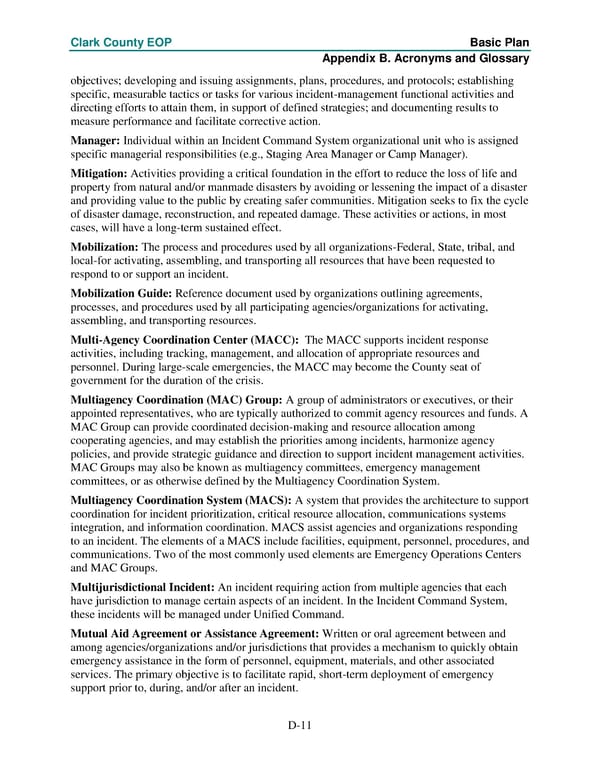Clark County EOP Basic Plan Appendix B. Acronyms and Glossary objectives; developing and issuing assignments, plans, procedures, and protocols; establishing specific, measurable tactics or tasks for various incident-management functional activities and directing efforts to attain them, in support of defined strategies; and documenting results to measure performance and facilitate corrective action. Manager: Individual within an Incident Command System organizational unit who is assigned specific managerial responsibilities (e.g., Staging Area Manager or Camp Manager). Mitigation: Activities providing a critical foundation in the effort to reduce the loss of life and property from natural and/or manmade disasters by avoiding or lessening the impact of a disaster and providing value to the public by creating safer communities. Mitigation seeks to fix the cycle of disaster damage, reconstruction, and repeated damage. These activities or actions, in most cases, will have a long-term sustained effect. Mobilization: The process and procedures used by all organizations-Federal, State, tribal, and local-for activating, assembling, and transporting all resources that have been requested to respond to or support an incident. Mobilization Guide: Reference document used by organizations outlining agreements, processes, and procedures used by all participating agencies/organizations for activating, assembling, and transporting resources. Multi-Agency Coordination Center (MACC): The MACC supports incident response activities, including tracking, management, and allocation of appropriate resources and personnel. During large-scale emergencies, the MACC may become the County seat of government for the duration of the crisis. Multiagency Coordination (MAC) Group: A group of administrators or executives, or their appointed representatives, who are typically authorized to commit agency resources and funds. A MAC Group can provide coordinated decision-making and resource allocation among cooperating agencies, and may establish the priorities among incidents, harmonize agency policies, and provide strategic guidance and direction to support incident management activities. MAC Groups may also be known as multiagency committees, emergency management committees, or as otherwise defined by the Multiagency Coordination System. Multiagency Coordination System (MACS): A system that provides the architecture to support coordination for incident prioritization, critical resource allocation, communications systems integration, and information coordination. MACS assist agencies and organizations responding to an incident. The elements of a MACS include facilities, equipment, personnel, procedures, and communications. Two of the most commonly used elements are Emergency Operations Centers and MAC Groups. Multijurisdictional Incident: An incident requiring action from multiple agencies that each have jurisdiction to manage certain aspects of an incident. In the Incident Command System, these incidents will be managed under Unified Command. Mutual Aid Agreement or Assistance Agreement: Written or oral agreement between and among agencies/organizations and/or jurisdictions that provides a mechanism to quickly obtain emergency assistance in the form of personnel, equipment, materials, and other associated services. The primary objective is to facilitate rapid, short-term deployment of emergency support prior to, during, and/or after an incident. D-11
 Emergency Operations Plan Page 114 Page 116
Emergency Operations Plan Page 114 Page 116